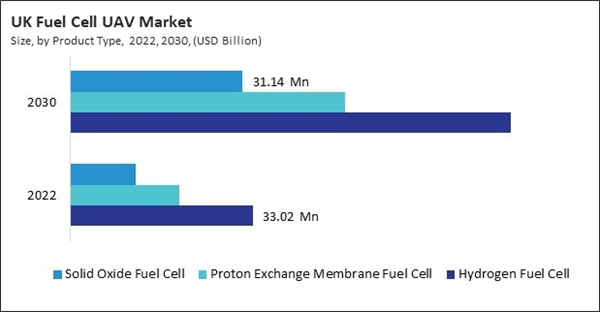The Germany market dominated the Europe Fuel Cell UAV Market by Country in 2022, and would continue to be a dominant market till 2030; thereby, achieving a market value of $172.3 million by 2030. The UK market is exhibiting a CAGR of 11.9% during (2023 - 2030). Additionally, The France market would experience a CAGR of 13.7% during (2023 - 2030).
Unmanned aerial vehicles (UAVs), commonly known as drones, have transformed various industries with their ability to perform various tasks autonomously. As the demand for longer flight durations, increased payload capacities, and reduced environmental impact grows, the UAV industry is witnessing a notable shift towards alternative power sources. Among these alternatives, fuel cell technology has emerged as a promising solution, offering enhanced endurance, reduced emissions, and improved efficiency compared to traditional power systems.
In addition, the integration of fuel cell technology into unmanned aerial vehicles (UAVs) represents a notable progression within the aerospace sector, propelled by the imperative for environmentally friendly and effective power alternatives. By undergoing electrochemical reactions between oxygen and hydrogen, fuel cells produce electricity while emitting only water vapor and heat as byproducts. This clean energy generation process offers several advantages over conventional power sources, including higher energy density, longer flight durations, and reduced environmental impact.
Poland's investment in fuel cell UAVs underscores its strategic focus on enhancing military capabilities. These UAVs offer versatility in various military operations, including reconnaissance, surveillance, and potentially combat missions. Fuel cell technology provides a more efficient and environmentally friendly alternative to traditional fuel sources. As per the data from the International Trade Administration, in May 2020, Poland’s national security strategy moved the goal of military expenditure to reach 2.5% of GDP in 2024 from 2030. This is largely on track with Poland’s 2022 budget, over USD14 billion, compared to USD10 billion in 2014. Therefore, the rising military expenditure and growing construction sector in Europe will increase demand for fuel cell UAVs in the region.
Based on Weight, the market is segmented into Less Than 50 Kg, and More Than 50 Kg. Based on Product Type, the market is segmented into Hydrogen Fuel Cell, Proton Exchange Membrane Fuel Cell, and Solid Oxide Fuel Cell. Based on Application, the market is segmented into Civil & Commercial, Military & Defence, Logistics & Transportation, Construction & Mining, and Others. Based on Type, the market is segmented into Rotary Wing, Fixed Wing, and Hybrid. Based on End-Use, the market is segmented into Cargo UAV, and Others. Based on countries, the market is segmented into Germany, UK, France, Russia, Spain, Italy, and Rest of Europe.
List of Key Companies Profiled
- Doosan Corporation
- Elbit Systems Ltd.
- The Boeing Company
- Northrop Grumman Corporation
- Textron, Inc.
- AeroVironment, Inc.
- Barnard Microsystems Ltd.
- Horizon Fuel Cell Technologies
- ISS Aerospace
- Plug Power, Inc. (EnergyOR)
Market Report Segmentation
By Weight- Less Than 50 Kg
- More Than 50 Kg
- Hydrogen Fuel Cell
- Proton Exchange Membrane Fuel Cell
- Solid Oxide Fuel Cell
- Civil & Commercial
- Military & Defence
- Logistics & Transportation
- Construction & Mining
- Others
- Rotary Wing
- Fixed Wing
- Hybrid
- Cargo UAV
- Others
- Germany
- UK
- France
- Russia
- Spain
- Italy
- Rest of Europe
Table of Contents
Companies Mentioned
- Doosan Corporation
- Elbit Systems Ltd.
- The Boeing Company
- Northrop Grumman Corporation
- Textron, Inc.
- AeroVironment, Inc.
- Barnard Microsystems Ltd.
- Horizon Fuel Cell Technologies
- ISS Aerospace
- Plug Power, Inc. (EnergyOR)
Methodology

LOADING...









